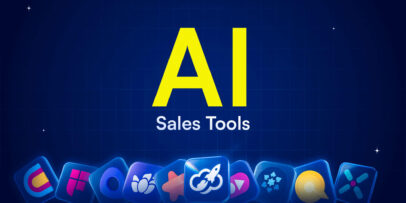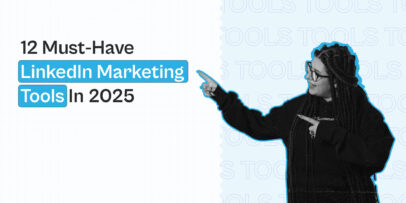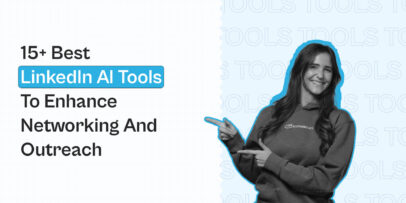Top 30 LinkedIn Automation Tools for Lead Generation in 2024

LinkedIn automation is all about using tools to automatically send connection requests, follow-up messages, and other manual LinkedIn activities.
Tools like Expandi make automation safe by putting your lead generation and outreach campaigns on autopilot while allowing you to focus on other business aspects.
Here’s why you should consider using LinkedIn automation tools:
- They save time as you won’t have to connect manually with your leads and send connection requests one by one.
- They bring personalization to mass outreach. This way, your user interactions and outreach messages will appear far more natural, no matter how many people you contact.
- They automatically generate reports for your outreach campaigns. Meaning you’ll be able to see who responded, replied, and converted.
- To have a competitive advantage and reach hot leads at the right time without manual effort.
- A/B testing becomes easier since you can experiment with different outreach requests and follow-up templates to see which ones get the most replies.
- They integrate with other lead generation and marketing tools. By combining your LinkedIn automation tool with other marketing tools like Zapier and Lemlist, you can bring a truly omnichannel approach to your LinkedIn marketing.
So, you already know about the beautiful benefits of LinkedIn automation for lead generation.
Maybe you’ve already tried some of the LinkedIn tools for lead generation.
But something’s not right.
Some are just missing apparent features, unsafe, or just plain awkward to use.
You’re ready to start generating leads on autopilot. You just need the right LinkedIn tool that will help you get there.
If that’s the case, we’ve got your back.
Here are some of the best LinkedIn automation tools to start generating leads in 2024:
Starting with:
How Do LinkedIn Automation Tools Work?
LinkedIn automation tools help expand your outreach to reach leads faster and efficiently.
Sounds obvious, right?
There are many reasons you should consider using a LinkedIn outreach automation tool.
Mainly because, after a while, your tasks become repetitive. Sending connection requests, cold messages, and email follow-ups are all hard manual work. Especially when you must change the template or text for each message.
Which is why you can use the best LinkedIn automation tools below to help speed up this process.
Another thing worth mentioning here is that there are different types of LinkedIn automation software.
Some help automate your outreach sequences, while others help you create content faster or scrape contacts from LinkedIn.
Below, we’ll be covering all kinds of LinkedIn automation tools to use for lead generation in 2024.
The tools we’ll be covering include:
- Expandi
- Lempod
- Salestools.io (ex-Demand)
- Phantombuster
- TexAu
- Dux-Soup
- MeetAlfred
- LinkedHelper
- Salesflow
- LinkedFusion
- LeadConnect
- Wiza
- We-Connect
- Dripify
- UpLead
- Reply
- LiProspect
- Linked Radar
- Zopto
- Skylead
- Waalaxy
- SalesLoft
- SaleeAI
- Taplio
- Evaboot
- La Growth Machine
- SocialPilot
- LeadFuze
- Mailshake
- Octopus CRM
For each of these best LinkedIn tools, we’ll be looking at their standout features, who they’re for, and tool pricing.
1. Expandi
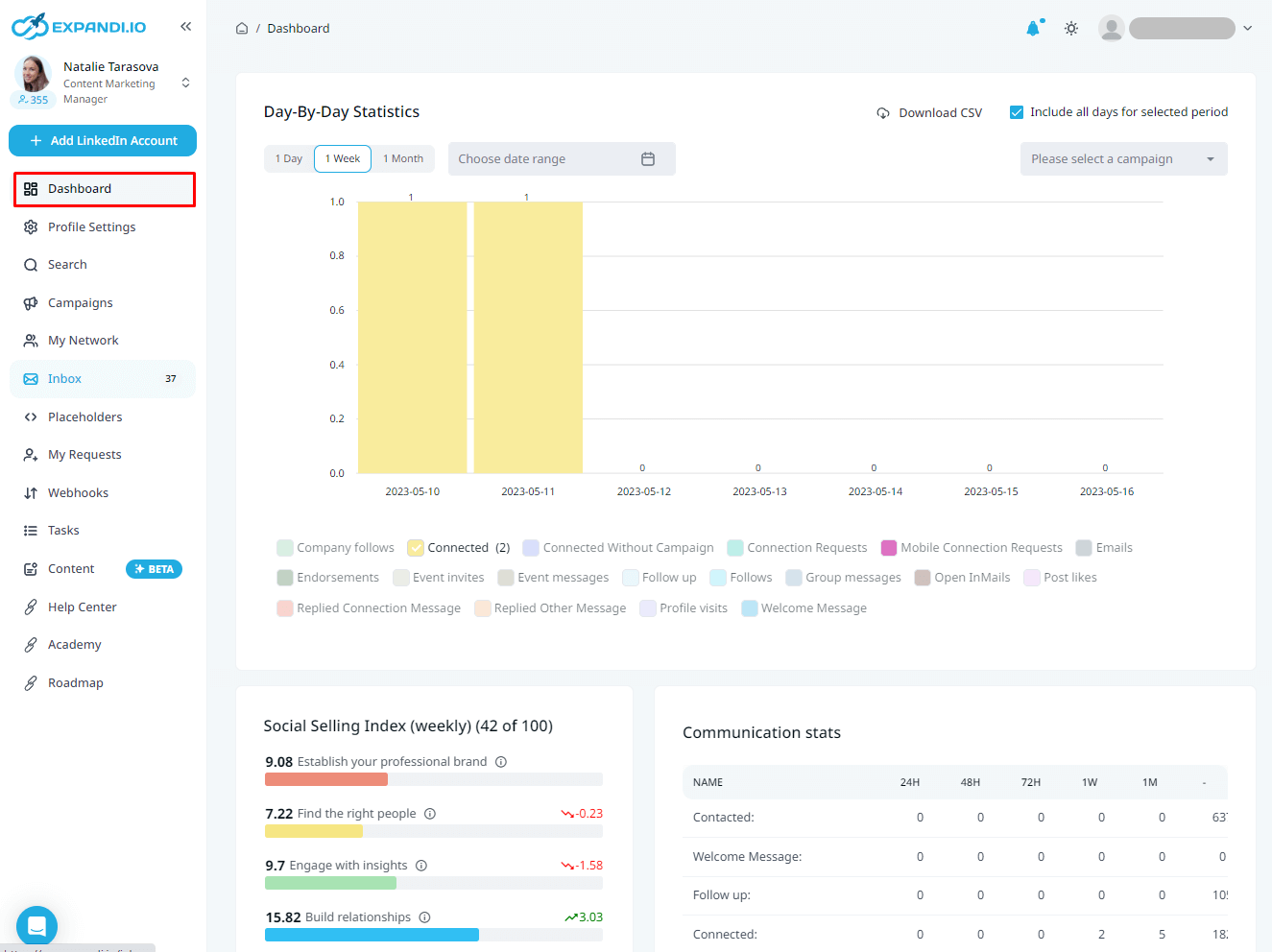
Yes, that’s us.
But hear us out.
Expandi is awesome.
It’s THE safest LinkedIn tool on the market (a bold claim, but we can back it up). It’s super convenient as it runs 24/7 on your computer (or at specific times, depending on your settings), and it’s extremely easy to set up.
It’s what we use, and we have a ton of case studies and growth hacks of successful campaigns on our blog.
Like that time, we got 40+ demos in a week on autopilot with NO ad spend.
PS – be sure to meet the Expandi team while you’re here!
Tool standout features
Here’s what makes Expandi a tool like no other:
- Webhooks – You can link Expandi to your other marketing tools. You can even throw Zapier into the mix to create a powerful omni-channel growth hack with hyper personalization.
- Smart Inbox – Let’s face it, managing your inbox natively from LinkedIn is a mess. Messages get lost, you’re limited in filters, and everything is just ten times worse if you manage multiple accounts. Luckily, Expandi has a dedicated smart inbox to boost customer engagement and ensure you never miss a chat conversation again.
- Dynamic Personalization – With dynamic personalization, you can message people based on a custom variable. This method goes far beyond ‘First Name’ and ‘Company Name’ personalization most people stop. We reached out to 42 people in one outreach campaign once and managed to gain an 83% response rate thanks to dynamic personalization. Check out the blog post to learn more.
- Safety – At Expandi, we take safety seriously. Unlike many other tools on this list, you get a dedicated and local IP address using the tool. With most LinkedIn tools, your IP is different each time you log in, and LinkedIn can tell if you’re logging in from a different country each time. This is not the case with Expandi, and you can rest easy knowing your account is in safe hands.
- And more – If you want a better idea of why Expandi works so well, you’ll need some context behind the history of LinkedIn automation tools. Learn how to generate leads without getting banned here.
Who is the tool for
Expandi was explicitly designed for growth hackers, agency owners, and people managing multiple LinkedIn accounts.
With an easy-to-use dashboard and being ability to switch between different accounts in a second – managing LinkedIn accounts has never been easier.
Tool pricing
Expandi starts at $99/seat per month and comes with a free 7-day trial to discover the best all-in-one sales automation software.
To claim the trial, just add me on Facebook, and let me know you’ve read this guide and that you’d like to try out the tool.
I’ll set you up with a demo and answer any questions you might have.
To learn more about Expandi and how it works, click here.
2. Lempod

Lempod is a well-recognized browser-based automation tool for LinkedIn. Top experts designed this instrument to focus on taking driving engagement via LinkedIn to the next level.
It is no secret that LinkedIn posts with the most engagement are the ones users see first. Lempod took the crucial task of helping its clients ensure the top engagement possible.
The tool finds and joins different pods in your industry to make it happen. To works like that – you post something and every user in the selected pod likes and comments on your post automatically.
Yet, along with driving engagement, Lempod has more aces up its sleeve. Let’s take a look at some of them.
Tool standout features
Lempod is an engagement-driving tool with a focus on automating LinkedIn posts.
Here are some key features the instrument entails to help clients boost post engagement:
- Company Pod Creator – You can create a unique pod for your company, making it invisible to everyone except your colleagues.
- Multi-User Collaboration – The tool offers dashboards and spaces for multiple users to collaborate and see what is happening with LinkedIn posts being automated.
- Brand Tracking – Automatically evaluates various brand KPIs and data points based on the social media engagement rate.
- Content Management – Provides a toolkit for composing LinkedIn posts and editing existing ones to get the best reception.
- Social Media Analytics – Collects various data points and visualizes it within collaborative spaces.
Who is the tool for
Naturally, Lempod is a tool for companies that want to drive their engagement and make a brand more recognizable.
This tool is best for creating excellent content and adopting growth hacks for getting the initial engagement businesses need.
If you are starting a LinkedIn campaign and need likes and comments, key engagement drivers, Lempod should be among your top choices.
Tool pricing
Lempod is well-known for its simple pricing. Essentially, there are two pricing options to choose from:
- Marketplace package – $9.99 per pod.
- Prive Business Pod package – $3.99 per user in a pod.
Lempod is a good starting point for your LinkedIn campaign. Keep in mind the tool only gives a 3-day free trial. Yet, there are better options available.
3. Salestools.io (ex-Demand)
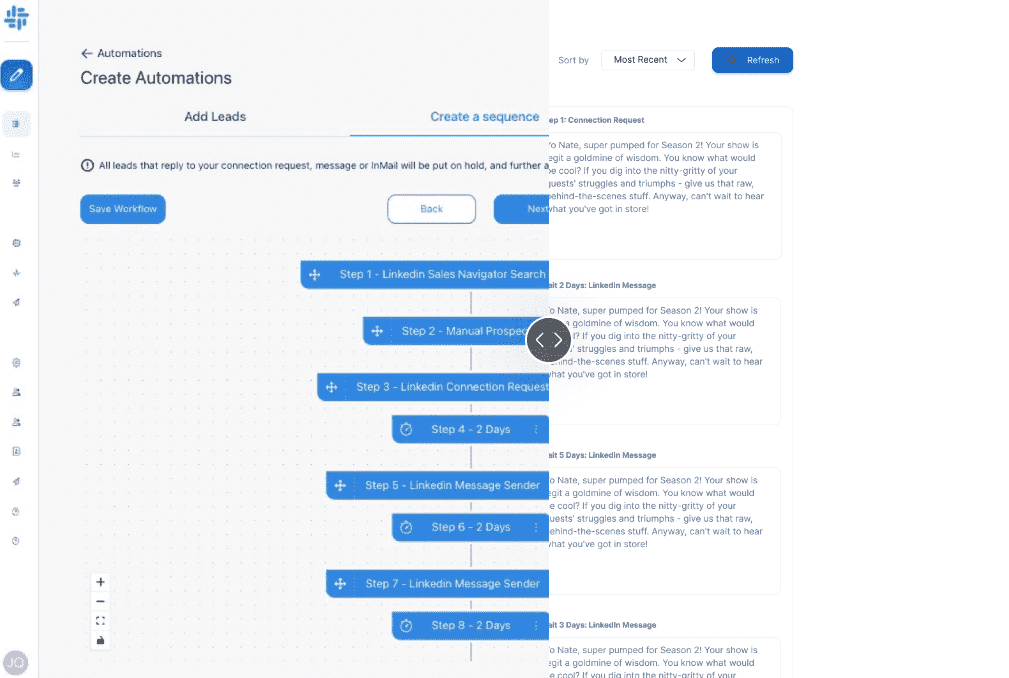
Salestools.io (ex-Demand) is a LinkedIn automation and personalization tool and an AI sales assistant with several use cases for businesses.
It uses AI to analyze prospect replies and identify their tones between positive, negative, or neutral. Apart from LinkedIn, Salestools also focuses on email automation to help sales teams build a multi-channel outreach system.
Tool standout features
- Double Verified Emails – Applies a double-ended email verification system to boost the quality and security of emails.
- LinkedIn Export – Exports LinkedIn leads and auto syncs data like emails and contact details to your CRM.
- Visitor Tracking – Automatically identifies the real website visitors in real time.
- Slack Integration – Creates a dedicated Slack channel tracking and reporting any LinkedIn-related activity.
Who is the tool for
Salestools.io is all about automation. You can easily use this platform with something like Phantombuster.
If you are looking to automate LinkedIn-related processes and have an opportunity to track the process in one place, consider Demand.
Experts behind the platform indicate it brings a 4x connection rate increase.
Tool pricing
Salestools.io provides three distinct plans:
- Sales Acceleration – $59/user/month
- All-In-One – $99/user/month
- Social Selling – $59/user/month
4. Phantombuster

Phantombuster is a code-free automation and data extraction tool that helps businesses generate leads, scrape audiences, and automate growth.
The extension can automate most actions you do on the web, schedule tasks, chain automation, and more.
And as of now, it only works with the following channels: LinkedIn, Sales Navigator, Instagram, Google, and Twitter.
But we’re focusing on LinkedIn here.
So, let’s see what the tool offers for the platform.
Tool standout features
Phantombuster is based on phantoms that can extract data and perform certain automated actions.
Here are a few key features of LinkedIn:
- LinkedIn Network Booster – Automatically send invitations and connect to a list of LinkedIn users.
- LinkedIn Profile Scraper – Collect data (name, title, position, etc.) from LinkedIn profiles.
- LinkedIn Message Sender – Automatically send personalized messages to LinkedIn connections.
- LinkedIn Auto Commenter/Liker – Automatically engage with certain posts of your connections and other LinkedIn users.
- And more
Who is the tool for
Phantombuster offers a ton of different features and automation hacks.
But it’s best used together with a LinkedIn automation tool of your choice.
If you’re looking for new growth hacks and want to save time scraping profiles, you can extract your audience using Phantombuster and use a LinkedIn automation tool to reach out to them.
Tool pricing
Depending on your requirements, Phantombuster can cost anywhere from $0-$900.
Used together with a LinkedIn automation tool, this tool can save you a lot of time and get you ahead of your competitors.
Check out our outreach strategy using Phantombuster to get an idea of what you can achieve with the tool.
5. TexAu
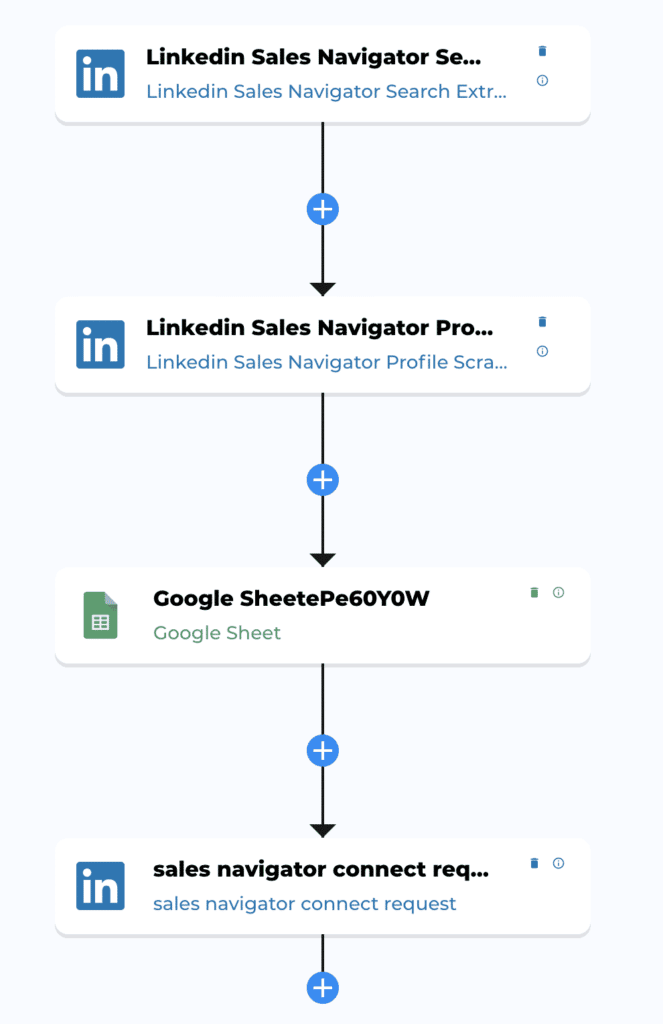
TexAu is a combination of two words: text and automation.
Like Phantombuster, TexAu is also a growth automation platform that helps you scale your business faster by extracting all the data you need and automating certain tasks to save time.
The platform offers automation for several websites (including Facebook, Twitter, Instagram, Quora, and 6+ others).
But we’re focusing on LinkedIn here, so let’s start there.
Tool standout features
Here are some of the many key LinkedIn automation features TexAu offers:
- Extract Saved Leads List From Sales Navigator – Extract profiles from a saved Sales Navigator search.
- Find Email Using LinkedIn Profile – Scrape emails from specific LinkedIn profiles.
- LinkedIn Group Members – Scrape all the members of a LinkedIn group you’re a part of. You can reach out to them then using different task automation.
- Auto Endorse, Like, Comment, or Message – Automate all these tasks for target profiles or posts.
- And more.
Who is the tool for
As with Phantombuster, you can use TexAu on its own. Or you can scrape data with it, and use a separate LinkedIn automation tool for a more efficient outreach.
For the most part, TexAu focuses on getting you all the information you need for the right growth hacks. You can also verify your emails with its built-in data enrichment features and use it as a CRM.
Is it better than Phantombuster?
Like with most things, it depends!
Luckily, both offer a 2-week free trial to find out.
Tool pricing
TexAu starts at $59/month and goes up to $399/month for Cloud agency support. Which is good. Especially if you’re using it with a LinkedIn automation tool.
Note: We’ve successfully used TexAu as part of our growth-hacking tactic to steal our competitor’s audience. Keep an eye out for our omnichannel outreach growth hack using TexAu in the future.
6. Dux-Soup
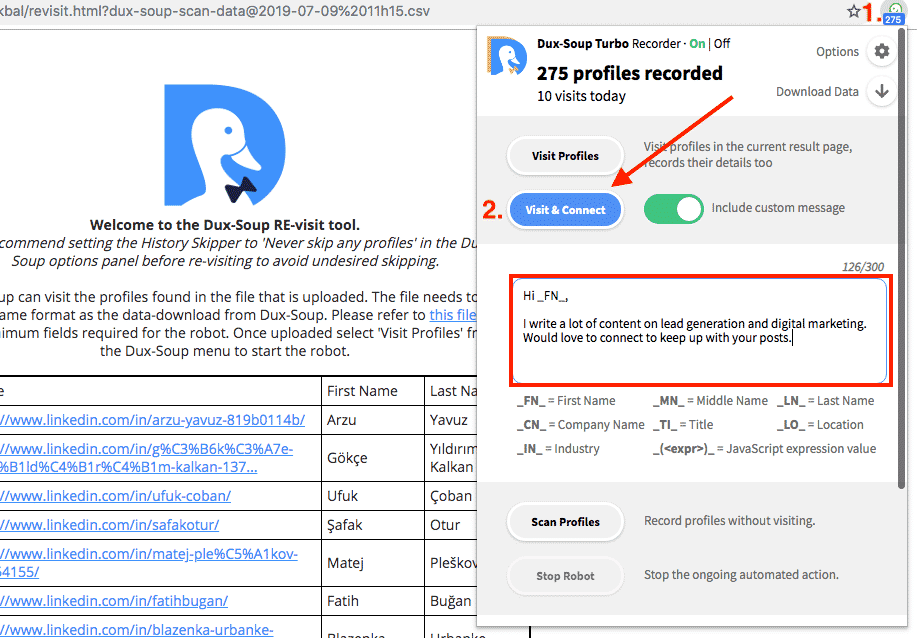
Dux-Soup is one of the most popular LinkedIn automation tools on the market that makes it easy to connect and engage with your prospects.
But it’s also a Chrome extension.
Meaning it lives in your browser, and you’ll need to have LinkedIn open the whole time in your browser, in the background, to run the tool.
Nevertheless, Dux-Soup is also an extremely straightforward tool and has much support for beginners just getting into LinkedIn.
Let’s look at some of its features to see if it’s worth it.
Tool standout features
Dux-Soup focuses primarily on the main lead generation activities and outreach features. Such as:
- Managing Prospects – Leave notes and tags directly on the LinkedIn profiles you want to target and reach out to them automatically.
- Downloading Profile Details – Easily find LinkedIn profiles and their info, and upload them into your CRM for easy lead management.
- Outreach, Automation, and More – Auto-visit profiles, send personalized messages, endorse connections, and more.
Though most LinkedIn automation tools also have these features, Dux-Soup also comes with a highly responsive customer support team.
Who is the tool for
Dux-Soup is a LinkedIn lead generation tool born out of necessity in 2016.
It’s mainly for teams and individuals looking for a straightforward and easy-to-use LinkedIn automation tool that lives directly in their browser.
To support its users, Dux-Soup also regularly publishes new guides to help users better manage their automation.
Unfortunately, the tool doesn’t offer many advanced outreach and safety features.
So, what you see is what you get. It’s mainly for beginners who want to automate their basic LinkedIn actions.
Tool pricing
Dux-Soup offers 4 pricing models:
- Free
- Pro Dux – $11.25/month
- Turbo Dux – $41.25/month
- Cloud Dux – $74.17/month
7. MeetAlfred

MeetAlfred, previously known as Leonard, is a decent jack-of-all-trades LinkedIn automation tool focusing mainly on end-to-end social selling campaigns.
Alfred helps with better team management, building LinkedIn campaigns, and automating outreach sequences.
Tool standout features
Here are some of the main features the tool offers:
- Campaign Manager – Create and run LinkedIn message sequences with all the classic personalization tags and action limits.
- Alfred CRM – Manage your leads and connections within the tool using its built-in LinkedIn CRM.
- Email Campaign Sequences – Go beyond LinkedIn, connect your GSuite account, and engage with your prospects via email.
While using the tool, you also get real-life analytics on its dashboard to monitor your progress and get actionable insights.
Who is the tool for
MeetAlfred offers a little bit of everything when it comes to LinkedIn automation.
But for the most part, Alfred is best used for driving engagement and managing conversions using its built-in CRM.
Using this LinkedIn automation tool, you can send bulk messages and multiple connection requests. But if you choose to do so, you should always keep in mind some of the main LinkedIn automation safety best practices.
With an excellent jack-of-all-trades approach, it has a mix of most features you’ll need for automated lead generation.
Tool pricing
Alfred offers 3 pricing options:
- Individual – $39/month
- Business – $49/month
- Agency – Custom pricing
8. LinkedHelper

As the name suggests, LinkedHelper is there to help you with LinkedIn social selling and marketing.
Linked Helper is a downloadable desktop software that can help you find targeted B2B leads on LinkedIn for almost any business.
With it, you can grow your network, build smart message chains, manage contacts, and essentially automate your LinkedIn lead generation funnel.
You can automate your work within LinkedIn, Sales Navigator, and LinkedIn Recruiter (Full & Lite).
Let’s take a look at what it offers.
Tool standout features
LinkedHelper helps expand your network with a few main key features:
Autoresponder for LinkedIn – Choose an outreach campaign, set up your templates, and run the autoresponder to reach out to your 2nd and 3rd-degree contacts.
Message LinkedIn Group Members – If you’re a member of a LinkedIn group, you can collect other members’ information and start messaging them even if they’re your 2nd or 3rd connections.
Export and Manage LinkedIn Contacts – With this, you can export your search results or import your custom CSV results into the LinkedIn tool for more specific targeting.
Who is the tool for
The primary use of LinkedHelper is to assist its users in automating several based LinkedIn tasks like connecting, messaging, inviting, endorsing, and more.
With this, you can expand your social network to an unlimited number of contacts in just a few automated steps.
And then, use the auto mailing system to reach all your contacts.
People that want to automate some surface-level LinkedIn tasks can do so using LinkedHelper at a lower price than many other tools.
Tool pricing
You can try LinkedHelper for free for 14 days or buy a monthly license for $15/mo – $45/mo (annual subscription).
To install Linked Helper, you have to download it as desktop software. You can install the tool on any popular operating system in under 15 minutes and receive a 14-day trial to test out the features
Since Linked Helper is a desktop application, it can be a safe way to automate your LinkedIn actions and avoid the safety issues that come with extension tools.
Learn why and how LinkedHelper compares to Expandi here.
9. Salesflow
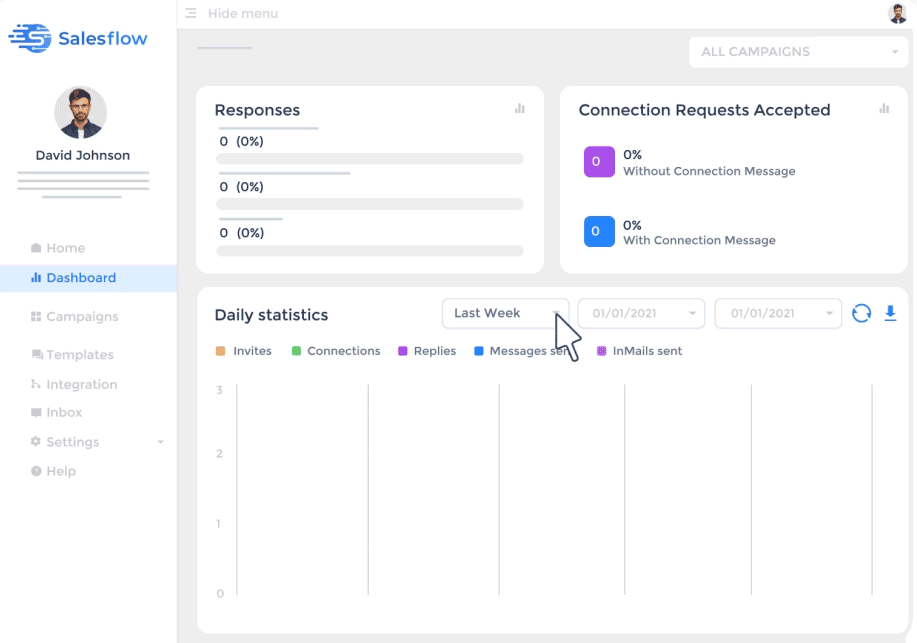
Salesflow is a new entrant in the market of LinkedIn automation. Yet, it earned an excellent reputation as a LinkedIn prospecting instrument.
If you need to fill out your sales funnel with new leads, Salesflow has everything to do.
It achieved excellent prospecting by helping companies create appealing profiles, the ones attracting leads from the get-go.
What is more, when generating leads, Salesflow can silmunteneosly run multiple campaigns with an unlimited number of messages pre-scheduled for posting.
While this instrument is not a one-fits-all solution, it has some unique features.
Tool standout features
Salesflow is one of the few tools tapping into AI-based growth hacks. This helps users with data effectively and efficiently.
Here are several standout features Salesflow provides for LinkedIn automation:
Automatic Invites Sending – Finds the most-fitted prospects for the outbound process, uses advanced filtering, and automatically sends invites to the prospects.
Follow-up Messaging – Grants unlimited follow-ups allowing you to maximize both a response rate and increase the number of appointments.
Advanced Reporting and Statistics – Gives a comprehensive understanding of your campaign, including factors like volumes and response rates.
AI-Driven Lear Management Inbox – Uses AI reply detection, advanced filters, and tags to manage all your inbound and outbound messaging in one place.
Hyper Personalized Targeting – Automatically creates multiple campaigns for the different market segments to increase the prospects.
CSV Imports and Exports – Offers exports and imports of data into and from the CSV format.
Who is the tool for
Salesflow is a tool known for its advanced automation, unlimited follow-ups, and excellent reporting.
If you want growth hacks focusing on AI tools, the tool is for you. Yet, keep in mind handling AI is not a simple task. That is why this instrument is not for beginners.
Try out Phantombuster first and then switch to Salesflow when you have enough experience with LinkedIn automation.
Tool pricing
Depending on the toolkit you’re looking for, Salesflow can charge different prices. Yet, the starting price is $99/month. Besides, there is a free version available with a limited number of features.
10. LinkedFusion

LinkedFusion is a great lead-generation tool. Designed to integrate with well-recognized platforms like Google Sheets, Zapier, and Hubspot, these instruments will increase your LinkedIn automation stack by a massive bunch.
LinkedFusion brings forward some unique methods that other tools do not have. It focuses on top-grade security by offering users dedicated exclusive IPs.
Why do you need a dedicated IP when you use LinkedIn?
Simply put, it makes the client-server connection more stable and secure. The automation process will go much smoother than without a dedicated IP.
Tool standout features
With Salesflow, you get these features added to your LinkedIn automation arsenal:
Cloud-Based Storage – The tool’s storage is cloud-based, which can be easily transferred, managed, and protected.
Teammate Feature – Automatic sending connection requests to your teammates.
Customer Support – The LinkedFusion team grants both sales and technical support for free.
Smart Inbox – Provides a feature for tagging conversations for easy and smooth chat filtering.
Graphical Analytics – Offers graphical analytics dashboards allowing users to track and manage the entire outreach potential.
LinkedIn Training LinkedFusion Academy – The academy helps users learn advanced growth hacks and show how to implement them without hiccups.
Who is the tool for
Salesflow is among the tools that not only give you the toolkit for growth hacks but provide you with the knowledge to use the instruments as well.
It means both seasoned experts and complete beginners can use this platform.
There is always something new to learn about LinkedIn automation. And what can be better than learning from the professionals who stand behind the tool you use.
Tool pricing
In terms of pricing, Salesflow comes in different shapes and sizes. Essentially, you have three pricing options to choose from:
- Professional – $65.95/user/month.
- Grow – $95.95/user/month.
- Ultimate – $135.95/user/month.
Choose wisely, and it can bring you to the solution with the best quality-to-cost ratio.
11. LeadConnect

LeadConnect is a lead prospecting LinkedIn automation tool armed with various features making your LinkedIn-related activities a hundred times easier.
With the instrument, you can clearly define your target audience, which is the foundation for personalized messaging.
By the way, you can automatically send about 100 customized invite messages to prospects. Sound perfect?
There is no catch. LeadConnect does a great job of communicating with your prospects. And it does it in a manner that makes it hard for recipients to recognize they received the message from an automated tool.
Tool standout features
When speaking about LeadConnect’s arsenal, in particular, note the following features:
Outreach Message Templates –
Team Blacklist – Eliminating team members’ chances of reaching the same prospects makes the outreach campaign more effective.
Contact Database – Keeping the entire database of your target audience in one place, granting you easy access and searching options.
CRM Linking – Synching prospects’ profiles to Hubspot and other CRMs to make lead nurturing more effective.
Activity Tracking – Automatic tracking of all LinkedIn-related changes and prospects’ responses.
With the features above, you get sufficient tools to start your growth hacks and proceed with the outreach campaign.
Who is the tool for
As a lead prospecting tool, LeadConnect is a perfect fit for startups and SMEs that want to automate LinkedIn prospecting and take their outreach campaigns to another level.
You can accompany LeadConnect with Phantombuster to tap into various automation hacks, as well as get advanced analytics and reporting on your hands.
With both tools, you can extract prospects’ data with Phantombuster and automate messages, invites, and responses with LeadConnect.
Tool pricing
Depending on your outreach needs, your company’s size, and your plans, LeadConnect can cost from $0 to $78. Besides, there are four pricing plans available:
- Free Forever – $0.
- Professional – $22.95.
- Grow – $40.95.
- Ultimate – $77.95.
12. Wiza

Wiza is a Chrome-based sales outreach tool designed and built for LinkedIn. The exciting thing about this instrument is that it connects to your Sales Navigator, bringing the power of both platforms together.
Sound complicated? In reality, it is easier than it may seem.
All you need to do is to insert the potential prospects’ search into your Sales Navigator account.
Yet, this is not all that the platform offers. So, let’s see what else it can do.
Tool standout features
Wiza is the instrument emphasizing smooth integration with Sales Navigator. Besides, it also focuses on smooth automation and data extraction.
Here are some standout features making Wiza recognizable:
Sales Navigator Automation – This entails the smooth exporting of verified leads and email addresses from Sales Navigator to CSV or chosen CRM.
Individual Profile Finder – Automatically finds selected emails for chosen LinkedIn profiles.
Chrome Extension – Easy process of setting up a Chrome extension with an option of exporting up to 20 emails without any charge.
Personalized Payment Options – Presents various customized payment options, thus appealing to a broader audience of potential customers.
Salesforce Integration – One of the few tools with direct Salesforce integration, which is great for boosting your outreach campaign.
Who is the tool for
Wiza indicates it delivers a staggering 99.5% deliverability. If that’s true, you and your sales team can use the tool to automate LinkedIn processes and then focus on some more pressing matters in turn.
Wiza is a real-time prospecting tool that delivers. It is suitable for growing companies and enterprises.
The company leverages LinkedIn data in real-time and can sustain a massive outreach campaign with about 2,500 enriched contacts in a single click.
Tool pricing
Wiza offers 3 pricing packages:
- Free forever
- Email – $83/month
- Email + Phone – $166/month
Besides, the tool entails an interesting credit system. It means the more you use Wiza, the greater number of perks will be available to you.
13. We-Connect
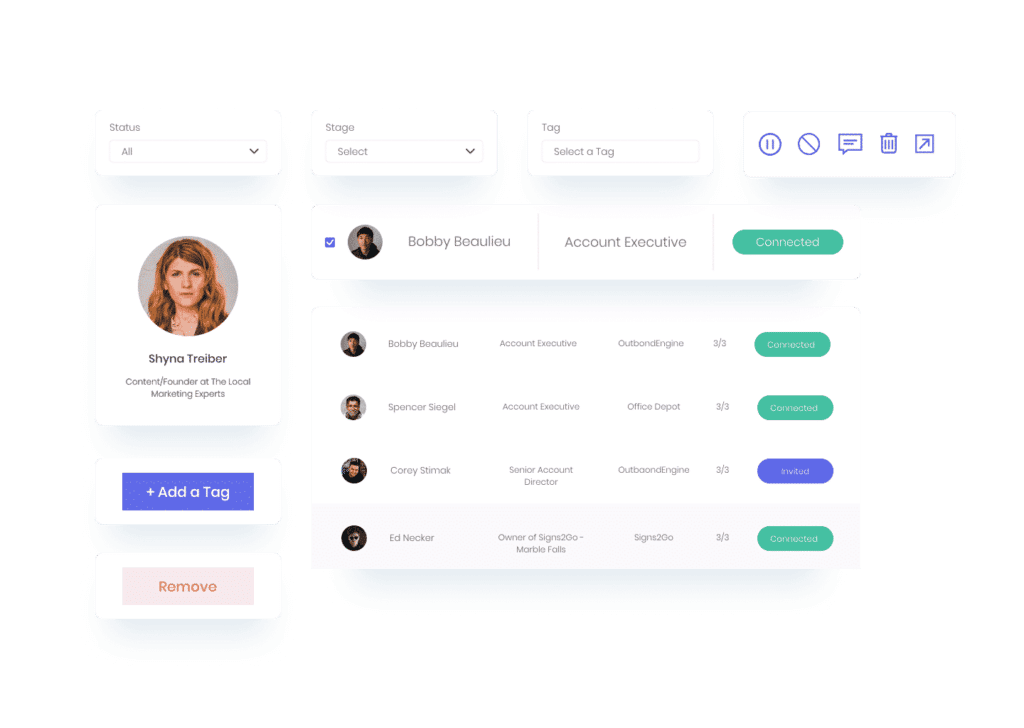
WeConnect is a cloud-based LinkedIn automation tool that helps prospect, nurture, and close more deals.
Simply by being cloud-based, it’s already more secure than some browser tools.
But let’s take a look at what the tool offers in terms of its main features.
Tool standout features
WeConnect helps automate professional networking on LinkedIn with a personalized and convenient approach.
Here’s how it works:
Powerful Campaign Manager – Set up and run multiple campaigns based on a custom target audience.
Smart Reply Management – See and reply to your prospects all in one place. Make new connections, discover new opportunities, endorse skills, and more.
Easy User Management – Add more users within your account, get a bird’s eye view of your LinkedIn campaign reports, and monitor everything from one convenient dashboard.
Who is the tool for
WeConnect is a convenient LinkedIn tool that’s easy to get into for most people.
It was specifically designed for busy sales teams, marketers, recruiters, and other professionals.
So, it’s not for everyone.
It comes with the necessary features, a clean interface, and simple usability.
But it does not have a lot of advanced features.
Tool pricing
WeConnect has a very straightforward pricing model.
It’s $69 per user/month.
And you pay as you go, based on the number of users you manage.
Learn more about how WeConnect compares to Expandi here.
14. Dripify
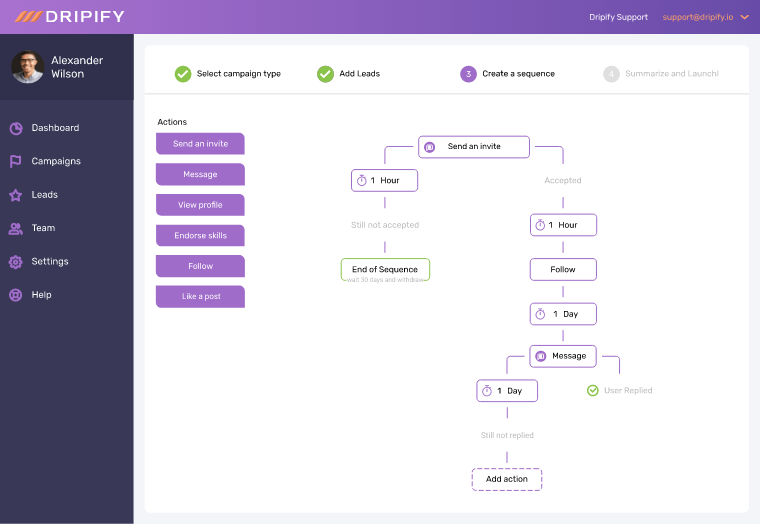
Dripify is an advanced LinkedIn automation tool used for effective lead generation.
As a user, you can use this instrument to set up your sales funnel in just minutes. Dripify does the rest.
People standing behind this instrument are intended to boost LinkedIn prospecting. More specifically, they wanted to create a tool to help users close deals much faster.
Do they succeed? Let’s find out.
Tool standout features
Diripify argues that it can make LinkedIn prospecting a breeze and a painless journey. That is why the platform focuses on these standout features:
Drip Campaigns – Create effective sales funnels with various LinkedIn actions from pre-set and customized Drip campaigns.
Data Export – Automatically download lead-related data, including emails and phone numbers.
Advanced Analytics – Easily track and assess outreach campaign performance and conversion rates.
Lead Responding – Automatically respond to incoming messages from leads using different customized patterns.
Team Management – Effectively manage onboard team members and watch statistics in real-time through a control panel.
Safety Algorithms – Dripify-specific extra safety algorithms adopted to ensure top-grade LinkedIn account security.
Who is the tool for
Dripify provides multiple features aiding your sales funnel and outreach.
As a critical growth hack, you can create different drip campaigns with particular LinkedIn actions automated.
The tool has a user-friendly interface and intuitive design, so even a beginner in LinkedIn automation can easily use it.
Tool pricing
To try the tool with its limited functionality, you can use a seven-day free trial. To get the most out of Dripify, choose between these pricing packages:
- Basic – $59/month.
- Pro – $79/month.
- Advanced – $99/month.
If you don’t know where to start with LinkedIn automation, Dripify is a great starting point. Its interface makes it easier to deal with drip campaigns and brings LinkedIn automation to the next level.
15. UpLead
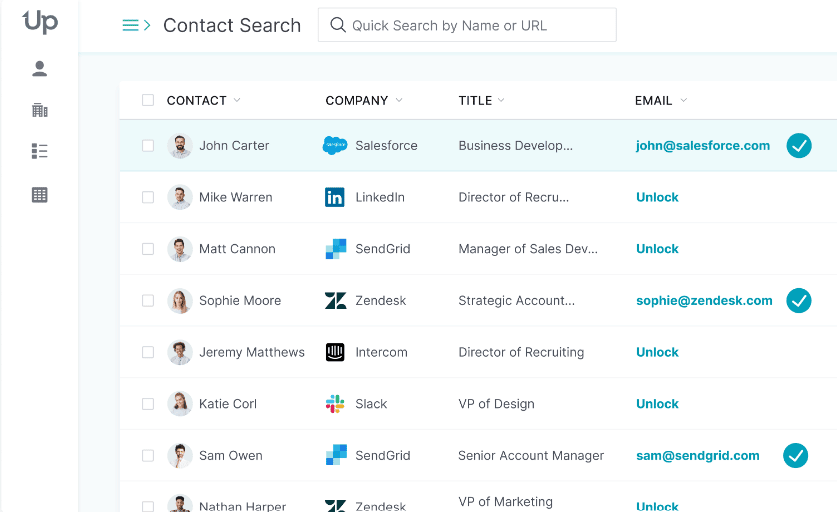
UpLead is a B2B prospecting tool that offers high-quality contact and company data.
The instrument allows users to verify prospects’ emails in real-time, use 50+ LinkedIn search criteria options, and apply its unique competitor intelligence software.
if that’s not enough, Uplead integrates with more than the 12 most recognized CRMs.
Uplead argues there are there about 108,000,000 LinkedIn contacts in 200+ countries. With the platform’s help, you can easily find the so-needed prospects for your lead generation campaign.
Keeping all these aspects in mind, let’s see a bit close to what comes into Uplead’s toolkit.
Tool standout features
UpLead is all about searching, filtering, and verifying. In such a case, its standout features include these:
Rich Profiles – An easy envisioning of your leads by assessing their detailed profiles.
Advanced Filtering – Automatic searching for prospects using over 50 filters, such as location, industry, management level, revenue, and many more.
Technographics – Generating qualified leads per particular technology type they adopt.
Account-Based Marketing – Initiate lead generation and outreach campaigns by identifying specific accounts to target.
Real-Time Verification – Automatic real-time email verification, which guarantees on-time delivery.
Bulk Processing – The ability to quickly and safely upload any volume of data.
Data Points – Enrich your database with more than 50 data points on prospective leads.
Who is the tool for
With UpLead, you can achieve 95% data accuracy in B2B prospecting and lead generation.
The tool offers various promises and considering recent customer reviews, the platform manages to keep its promises.
If you are looking for growth hacks directed at B2B prospecting, and data accuracy is the key concern, UpLead is the candidate worth considering.
Tool pricing
UpLead offers a week-long free trial. Yet, if you want to get access to the tool’s entire arsenal, you should pay per these pricing options:
- Essentials – $99/month
- Plus – $199/month
- Professional – Custom pricing
16. Reply

Reply is a simple LinkedIn automation tool. As the name itself entails, professionals working at Reply are all about working anywhere with messaging taking place.
What does it mean?
The instrument allows sales and marketing professionals to establish communication channels with customers.
Reply uses advanced inbound and outbound messaging technologies, for instance, chatbots and automatic messengers, to make it happen.
In other words, with Reply, you can be sure your sales and marketing teams will have a direct line of communication with your prospective clients. This line can be handled both manually and automatically.
The app’s toolkit focuses on versatility in messaging, as you might have guessed from what we talked about.
Tool standout features
Reply’s toolkit focuses on four segments – discover, engage, execute, and improve.
Deconstructing each one will take a lot of time. That is why we’ve selected some most notable features from the segments above. These are the following:
Web Crawling – Automatically detect and extract data on prospects’ emails and phone numbers.
Email Warm-Up – Uses LinkedIn premium product to find emails for lead generation and prevents spam sanctions.
Instant Messaging – Receive your messages via WhatsApp and SMS to reach people more conveniently.
Multichannel Sequence – This creates an opportunity to reach contacts from multiple channels, such as LinkedIn, email, Zapier, and social media messaging.
AI Assistant – Automatically send customized and human-like messages to prospects to maximize the response rate.
Collaborative Environments – Help your teams collaborate and work more effectively by keeping track of all LinkedIn actions in one place.
Advanced Analytics – Easily track down the results of LinkedIn automation and envision the data through customized dashboards to detect potential areas for improvement.
Who is the tool for
Reply is a tool designed to assist sales and marketing professionals. Because of its social media and SMS capabilities, it can be beneficial for both B2B and B2C users.
In a nutshell, Reply is best for covering two significant areas.
First, it cuts down the time required to reply to customer inquiries. Second, it makes messaging effortless.
The tool is there to help users establish two-way communication with prospects.
Tool pricing
With Reply, you receive a 14-day free trial. In terms of paid packages, there are three options to choose from:
- Email Volume – $49/month
- Multichannel – $89/user/month
- Agency – $166/month
17. LiProspect
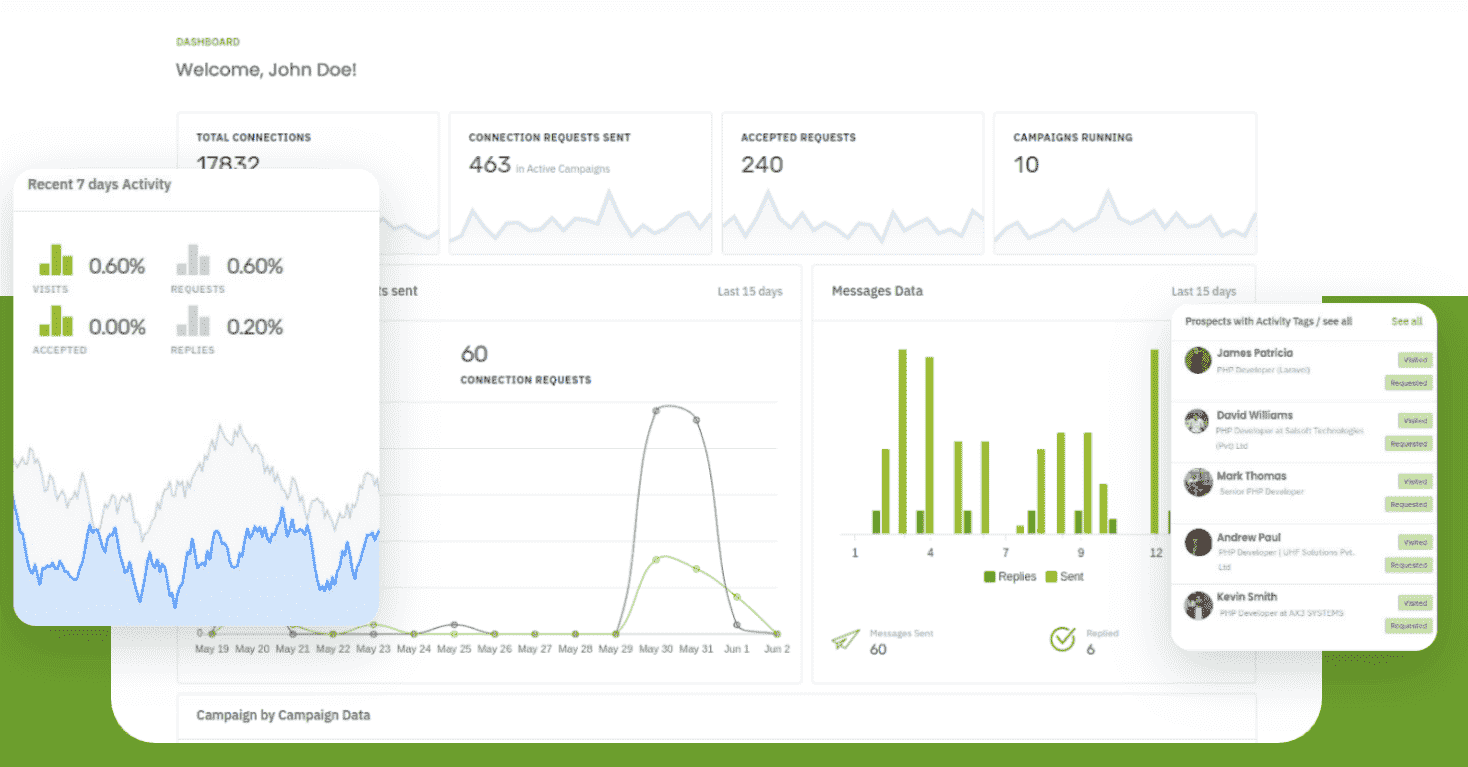
LiProspect is a LinkedIn automation tool with a focus on outreach campaigns and follow-ups being entirely on auto-pilot.
The platform brings forward some notable B2B sales and marketing techniques. These won’t leave your prospects and clients aside. Besides, with LiProspect, your banded messaging will be recognizable.
LiProspect values safety, efficiency, and speed. It promises to help you build a perfect LinkedIn outreach and prospecting campaign.
In any case, LiProspect is worth trying out. The list of its standout features is one of the reasons for doing that.
Tool standout features
There are particular aspects of LiProspect making this platform appealing. At this point, let’s cover some of the tool’s key features making it stand out:
Sales Navigator Imports – Harness Sales Navigator’s power in finding new leads by taking advantage of its advanced search filters and later importing the results.
Custom Listing Imports – With a single click import a list of selected contacts and activate your outreach campaign in a matter of seconds.
Blacklist Management – Easily blacklist selected accounts by simply copy-pasting profile links into the system.
Smart Inbox – Management all responses with the help of an intuitive inbox coming with various advanced features.
Dedicated 4G Mobile Proxy – Grants a specific 4 mobile proxy for each given account, which results in bank-grade security.
Cloud-Based Capabilities – With LiProspect, you don’t need to install it on your hardware or use it as a browser extension; everything you do within the platform is cloud-based.
Who is the tool for
LiProspect is a great LinkedIn automation tool bringing growth hacks through its multiple integrations and data import options.
It uses the power of AI and ML to automate lead generation. Keeping that in mind, B2B companies benefit most from the platform.
By the way, don’t be afraid of the advanced tech mentioned above. With the tool’s intuitive interface and knowledge base, a beginner can tap into its potential.
LiProspect is worth taking a shot at. It will introduce you to some next-level LinkedIn automation.
Tool pricing
While most platforms offer a seven-day free trial, LiProspect gives you 15 days to try the tool out for free. If that is not enough, you have two pricing plans to choose from:
- Personal – $89/month.
- Personal SalesNav – $109/month.
18. Linked Radar
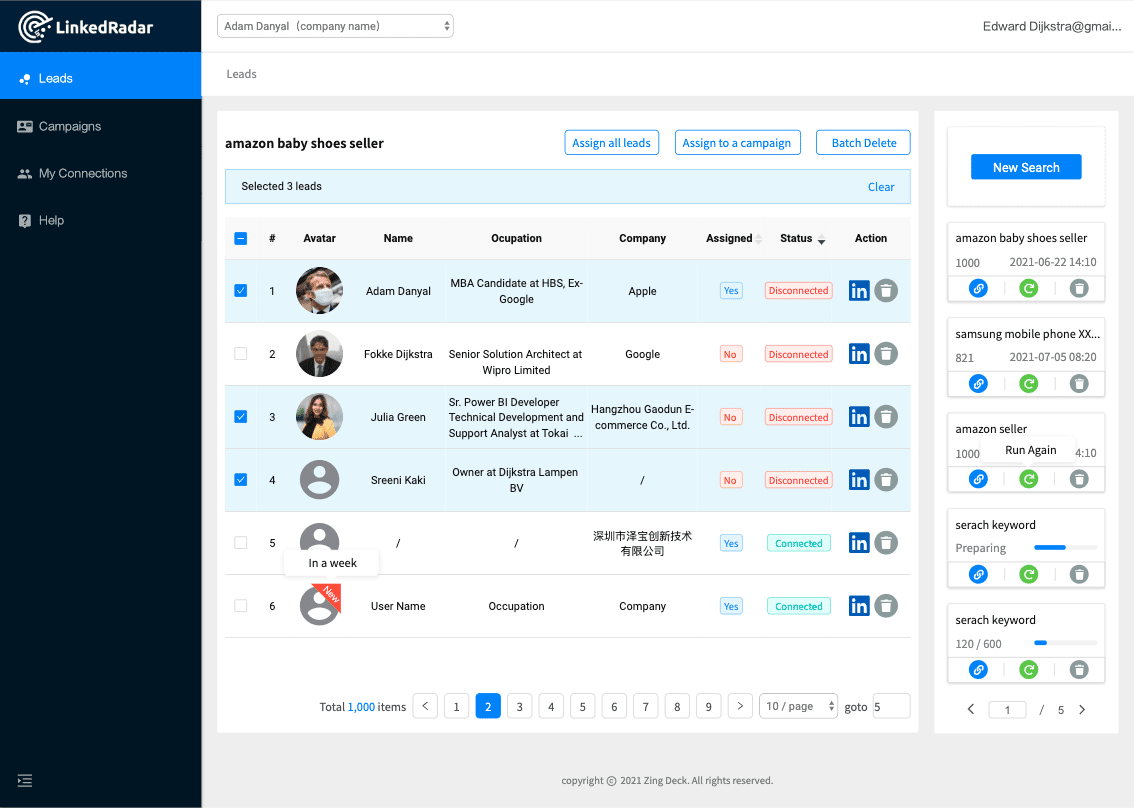
Linked Radar is coined as the safest LinkedIn lead generation and automated messaging tool.
Whether true or not, the platform promises a 10x boost in LinkedIn sales outreach.
Linked Rader tries to deliver its promises with unique approaches, the ones toward scrapping and messaging.
The fact that the platform has a high rating on multiple review services speaks for itself. Yet, to understand how Linked Radar delivers on its promises, it is vital to take a closer look at its toolkit.
Tool standout features
To understand Linked Radar, you must first focus on several standout aspects of its approach. There are two elements involved in that:
LinkedIn Scraper and Viewer method allowing to scrape thousands of prospects and profiles with only one keyword or URL.
Automated Messaging approach providing dozens of customized message templates proven to improve a response rate by a great deal.
In addition, Linked Radar also comes with these features:
Time Zone Selection – Changes the activity time for LinkedIn actions and profiles to determine when it is best to send automated messages to the prospect’s activity time.
Smart Limiting – Allows users to send up to 100 invites and messages per day to avoid account blocking.
Cloud-Based Activity – Automatically keeps LinkedIn generation running in the cloud even if your computer is turned off.
Human Behavior Mimicking – Reduces the account risk by mimicking LinkedIn users’ behavior, including randomized action delays.
Personalized Templates – Create highly-personalized templates with the help of LinkedIn experts to increase the response rate.
Who is the tool for
Linked Radar is suitable for different users. Whether you are a startup or an enterprise, there is something to find with the tool.
Besides, both B2B and B2C companies can adopt growth hacks offered by the platform.
On your part, you just need to prepare a Linked Radar account and enter a keyword. The platform will do the rest and take your outreach campaign to the stars.
Tool pricing
Linked Radar comes with a 30-days free trial. To increase the number of connections and messages per week, you should select one of the four pricing plans:
- Start Plan – $13.9/month
- Biz Plan – $23.9/month
- Pro Plan – $49.9/month
- Team Plan – $69.9/month
19. Zopto
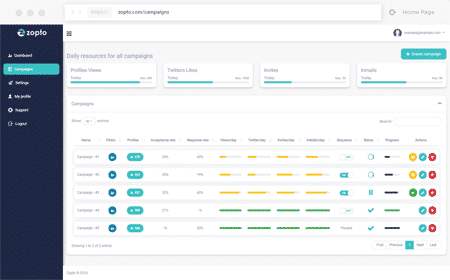
Zopto is a LinkedIn outreach automation tool that helps sales teams improve their lead-generation efforts.
You can filter your ideal customers and search using LinkedIn Premium or Sales Navigator.
Tool standout features
Here’s how Zopto helps businesses find their customers on LinkedIn and increase their sales and conversions.
Customer Filtering – Using Zopto, you can filter by location, industry, company size, title, seniority level, and more.
Levels of Engagement – Once you’ve selected a filter or your target audience, you can then match the desired level of engagement and turn on the relevant features like connection invites, message sequences, free InMails, and more.
Managing Leads – Finally, you can track your leads on your live dashboard, providing you with detailed information and statistics related to your LinkedIn campaign.
In short, Zopto offers all the essential LinkedIn automation features and unique ones like Twitter engagement, InMail messages, advanced reporting, and more.
Who is the tool for
Zopto is mainly for startups and sales teams looking to improve their lead generation and outreach efforts.
To make the most out of the tool, you should have a solid understanding of sales and LinkedIn automation.
Depending on your usage, you’ll also probably need LinkedIn Premium or Sales Navigator.
Things might get pricey quickly.
Tool pricing
Zopto offers 4 plans:
- Basic – $197/month
- Pro – $297/month
- Agency & Enterprise Basic – $156/user/month
- Agency & Enterprise Pro – $237/user/month
20. Skylead
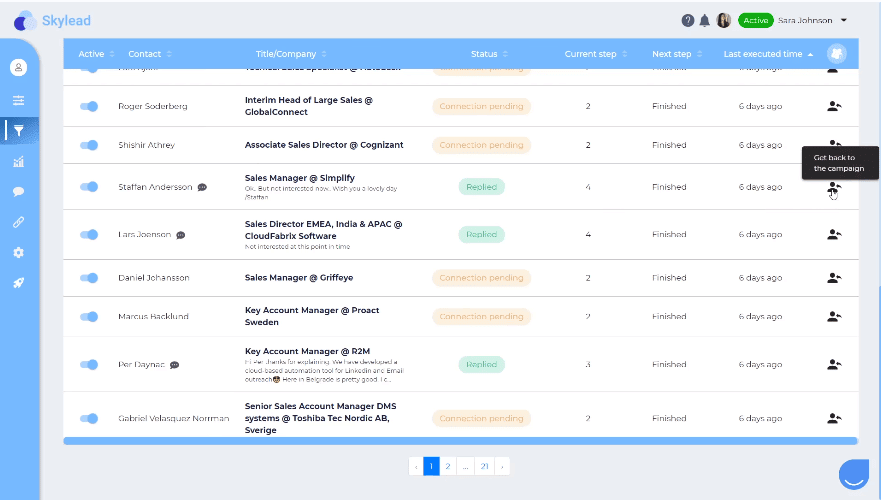
Skylead is a highly intuitive LinkedIn sales automation instrument. It helps businesses of all shapes and sizes to track leads and convert them into sales.
Skylead uses smart sequencing, allowing you to send hundreds of invites each week. Besides, its hyper-personalized approach toward outreach campaigns won’t leave you unpleased.
One of the unique aspects of the platform is its unique ability to combine LinkedIn and email outreaches.
There are plenty of things Skylead can deliver. This will be more visible when we investigate some of its standout features.
Tool standout features
Keep in mind that Skylead is all about personalization and being smart. These two key aspects give rise to these platform’s unique features:
Message Personalization – Include placeholders and branded messages to personalize outreach and stand out from the competition.
Drip Campaigning – Create a sequence from all three-degree connections by including personalized invites to connects, messages, and InMials.
Smart Reply Detection – Automatically stopping the process of sending messages as soon as a prospect replies.
Real-Time Insights – Tracking campaign performance with the help of detailed analytics showing all the major LinkedIn activities through a dashboard overview.
Light CRM & Smart Inbox – Integrate a LinkedIn account with an email to deal with the prospects in one place, keep track of all the leads, and focus on only the right prospects.
Cloud-Based System – Get a dedicated IP address to log into your system safely and from any device and operating system.
Who is the tool for
Skylead is an excellent tool for being closer to your prospects. Its automated features help communicate with the leads and increase conversion rates.
You just need to plug in and start benefiting from what the platform has to offer.
Importantly, Skylead is suitable for startups, SMEs, and Enterprises alike. Moreover, you do not need to be an expert in LinkedIn automation to use the platform’s intuitive interface.
With Skylead, you can take your outreach campaign far ahead, especially considering the 500+ invites you can send via the platform weekly.
Tool pricing
You can try out Skylead with its 7-day free trial. Besides, unlike many other tools, the platform abandoned various pricing plans and has an All-in-one plan.
For a $100/account/month, you get access to all the features, can have multiple users, and benefits from around-the-clock live support.
21. Waalaxy
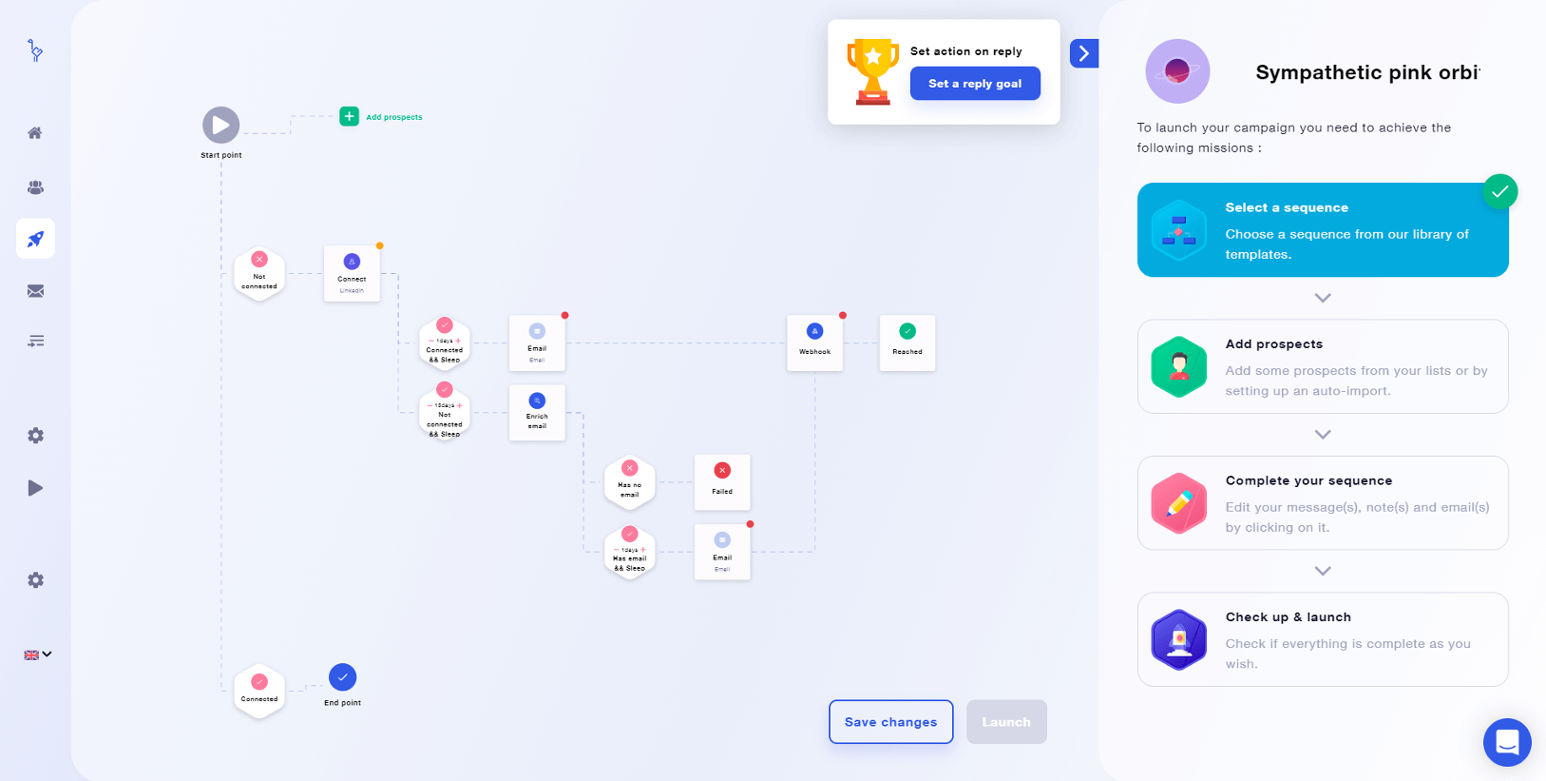
Waalaxy is a Chrome-based prospecting tool using sequence automation to bring the most of LinkedIn.
In the past, the platform was known as ProspectIn. However, after a comprehensive update, the tool became a well-recognized and powerful instrument for generating leads and marketing outreach campaigns.
There is not much to say about Waalaxy. It is a great lead-generation tool that rightfully occupies its place on our list.
With Waalaxy, you can generate clicks and approach sales partnership recruitments on LinkedIn.
Tool standout features
When it comes to some unique features Waalaxy has, there are several ones to mention:
Smart Contact Importing – With some basic features offered by Waalaxy, you can import up to 1000 LinkedIn contacts, and with premium features, the number can be as high as 2500.
Segmented Lists Build – The tool can classify the contacts into detailed lists and then segment each to have a more targeted outreach campaign.
Auto-Reroll – Automatically reminds a user of a particular campaign or sequence selected to ensure the outreach campaign is ongoing all the time.
Professional Email Extraction – The tool provides a collaborative feature with Dropcontact, which grants access to about 70% of professional email addresses used by LinkedIn prospects.
Visit Simulation – The tool simulates human-like visits to LinkedIn to create get LinkedIn activity and ensure the platform recognizes Waalaxy’s actions as human and not algorithmic.
Prospect Data Exports – Exporting prospects’ data into an external CRM solution to collect and update information continuously and have the most up-to-date outreach strategies.
Who is the tool for
Waalaxy is a great option for users looking to expand their contact database fast. It can significantly help sales professionals, marketers, startup founders, recruiters, and freelancers.
The growth hacks Waalaxy offers are the ones you might not find in other tools, especially when it comes to visiting simulations.
Most platforms use AI-based algorithms to extract and analyze data. Waalaxy taps into advanced algorithms to mimic a human-like interaction with LinkedIn.
Tool pricing
In addition to all its perks, Waalaxy has a free-of-charge package. It gives you up to 80 invitations per month. If you want more, there are two pricing packages to consider:
- Advanced – $60.8/month
- Business – $86.9/month
22. SalesLoft

SalesLoft is a well-recognized engagement platform allowing sales representatives and marketers to prioritize workflows.
The tool connects with a user’s CRM and establishes a smooth data inflow. Respectively, with the power of Sales Loft, you can plan and execute outreach campaigns of different broadness and complexity.
Some of the notable SalesLoft clients, for instance, Upwork, suggest this tool to be a one-stop shop for LinkedIn automation and live-execution coaching. The instrument helps marketers and sales representatives edit various real-time sales opportunities.
All these aspects take your outreach campaign management to another whole level. Yet, speaking about Sales Loft’s approach without its features will be unfair.
Tool standout features
Sales Loft does not have some unique features compared to other LinkedIn automation tools. However, what makes the instrument unique, is that it does a great job with some well-recognized toolkit almost every autoamtion platform has.
In general, Sales Loft comes with these features:
Contact Personalization – Easy-to-use personalization tools allow you to segment contact lists to make it easier to access each one.
Notes – Take notes and insights during the automation process and attach these to the contact lists to make the outreach campaign more accurate and personalized.
Link Activity Analytics – Track and assess all LinkedIn automation-related link activities to see how the outreach campaign unveils in real-time.
Email and Message Scheduling – Schedule automated messages and emails considering the time zones and prospects’ activity patterns.
Workflow Management – Get your hands on various workflow management tools to boost workflow management.
Who is the tool for
As mentioned above, Sales Loft is an excellent tool for sales representatives and marketers.
Yet, it does not matter if you are a beginner or a seasoned pro. You will understand how to use Sales Loft from the get-go.
In turn, if there is still something unclear with LinkedIn automation, here are some tips to make the picture clearer.
Tool pricing
The one thing unclear with SalesLoft is its pricing. For all three of its pricing plans – Essentials, Advanced, and Premier, you need to contact the team for a custom quote.
23. SaleeAI
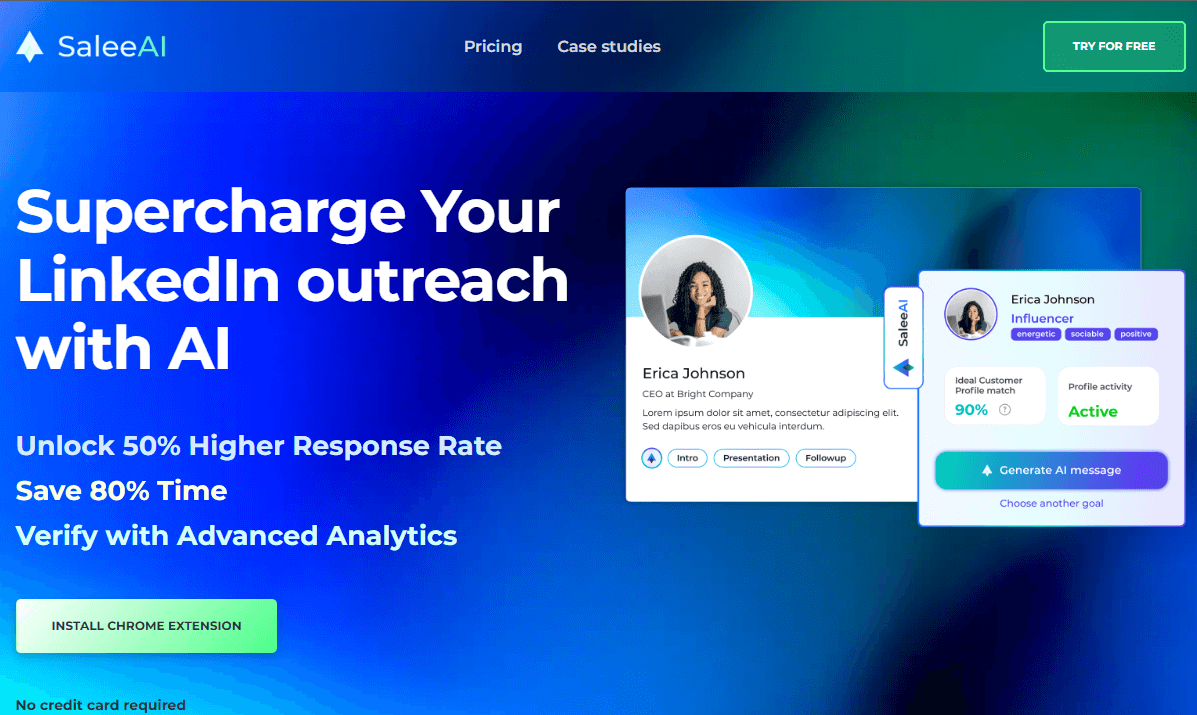
SaleeAI or Salee AI text generation is a text generation tool for LinkedIn automation.
More specifically, the tool helps you craft instant, personalized icebreakers to use in your outreach and boost your reply rate.
The tool analyzes your leads’ profiles, taking into account their company, industry, pain points, and goals – and then crafts a relevant sales message.
To get the most out of this tool, you need 2 things: A well-defined ideal customer persona (so the tool can tell how close of a match a lead it is) and a sales objective for the AI.
The objectives with its AI-driven outreach include:
Getting customer insights.
Personalizing connection requests.
Personalized warming up.
Product presentation.
Follow-ups.
Personalized icebreakers.
Closing deals.
And more.
Tool standout features
Salee lets you create personalized messages that will boost your sales success faster.
Here’s how the AI LinkedIn automation tool manages to do that:
Generating AI icebreakers based on the lead’s LinkedIn profile.
Rephrasing the sales message to make it sound more natural.
Create custom replies based on what your lead says, based on your objective.
Choose a goal and create a personalized message based on your unique solution.
Though Salee can help speed up your lead generation and outreach processes, it’s worth noting that the tool’s main use cases have to do with crafting sales messages.
As of now, the tool can’t automate your LinkedIn outreach activities.
You still have to do that yourself or with any of the other LinkedIn automation software listed in this article.
Who is the tool for
Anyone doing LinkedIn lead generation or outreach can use Salee to speed up their messaging.
But the LinkedIn tool is mainly for:
Business growth teams.
Marketers.
Sales development representatives.
Junior sales associates.
Business relations and recruiters.
Tool pricing
SaleeAI is a chrome-based extension that offers the following pricing options:
- Free
- Pro – $25/month
- Unlimited – $100/month
24. Taplio
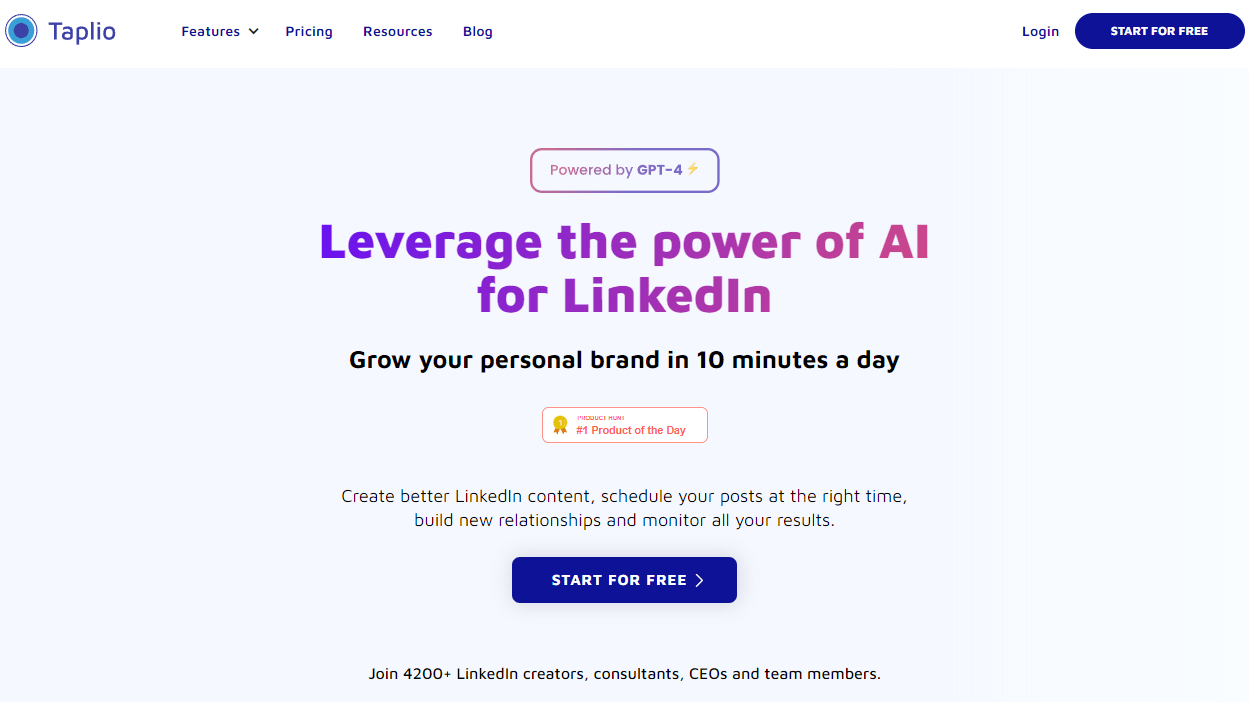
Taplio is a LinkedIn social selling tool that lets you schedule posts, build relationships, and monitor analytics – all from one place.
While you can also schedule posts natively from LinkedIn on your own, Taplio provides other features to get the most out of your LinkedIn content strategy and lead generation.
The LinkedIn lead generation tool also leverages the power of AI to get the most out of the platform. The way it does this is by giving you fresh ideas with AI-picked inspiration, viral post library, chat assistance, and more.
Then, once you create and schedule LinkedIn posts at blazing speed, you can turn likes, comments, and shares into relationships and study your LinkedIn analytics.
Tool standout features
Taplio is all about using AI and quality content to generate leads, build relationships, and grow your brand on LinkedIn. Here’s how it manages to do that:
LinkedIn content inspiration – Not sure what to write about? Get post ideas and become inspired by viral LinkedIn posts in a 4M+ high-performing post library.
LinkedIn post scheduling – Create and schedule your LinkedIn posts at blazing speed.
LinkedIn outreach automation – Create contact lists, engage with the right people, and send DMs all from one place.
LinkedIn analytics – Find out what’s working and what isn’t, and adjust your LinkedIn strategy by gaining access to main LinkedIn KPIs at a glance.
And more – As a Chrome extension, Taplio also offers other data and features for which you don’t have to pay for. You can identify your top performing posts, find other people’s best content, and more.
Who is the tool for
In a nutshell, Taplio can be helpful for anyone creating content on LinkedIn that want to elevate their brand. Whether you want to generate leads, build relationships, or grow your brand, you can use Taplio for your content needs.
Taplio users include:
LinkedIn creators.
Consultants.
CEOs.
Marketing influencers.
And more.
Tool pricing
Taplio has 3 main pricing plans, which include:
- Starter – $32/month
- Standard – $49/month
- Pro – $149/month
25. Evaboot

Evaboot is a Chrome extension that lets you directly export your leads from Sales Navigator into a spreadsheet file and also grab their emails.
One of the biggest downsides of LinkedIn Sales Navigator is that you can’t export leads from the platform directly.
So, to make things easier, you can use Evaboot to speed things up.
With it, you can export leads, clean data, filter leads, find and verify emails, and more.
While the tool doesn’t offer LinkedIn outreach automation, you can use it together with the other LinkedIn tools covered in this article.
Tool standout features
Evaboot is a chrome extension that helps boost your LinkedIn lead generation efforts through:
Data export and cleaning – Export lists and searches from Sales Navigator to CSV. Then, clean names, job titles, and company names right after they’re extracted.
Lead filtering – Stop spending hours double-checking your leads manually. Evaboot automatically detects false positives in your search results based on your lead filters.
Email finder and verifier – Evaboot uses 3 different sources to find the right emails (LinkedIn, web, algorithms), and then, it tests all emails to verify ones that really exist.
Team management -Connect unlimited Sales Navigator accounts without any additional costs and invite teammates to share export and email credits on the platform.
Who is the tool for
If you’re doing LinkedIn lead generation and outreach, Evaboot can help you build lead lists in seconds.
Tool pricing
When using Evaboot as your LinkedIn lead generation tool, you can buy credits with a one-time payment.
Export and email credits annual subscription prices are as following:
- 100 credits/month – $8/month
- 1500 credits/month – $41/month
- 4000 credits/month – $83/month
- And so on
26. La Growth Machine
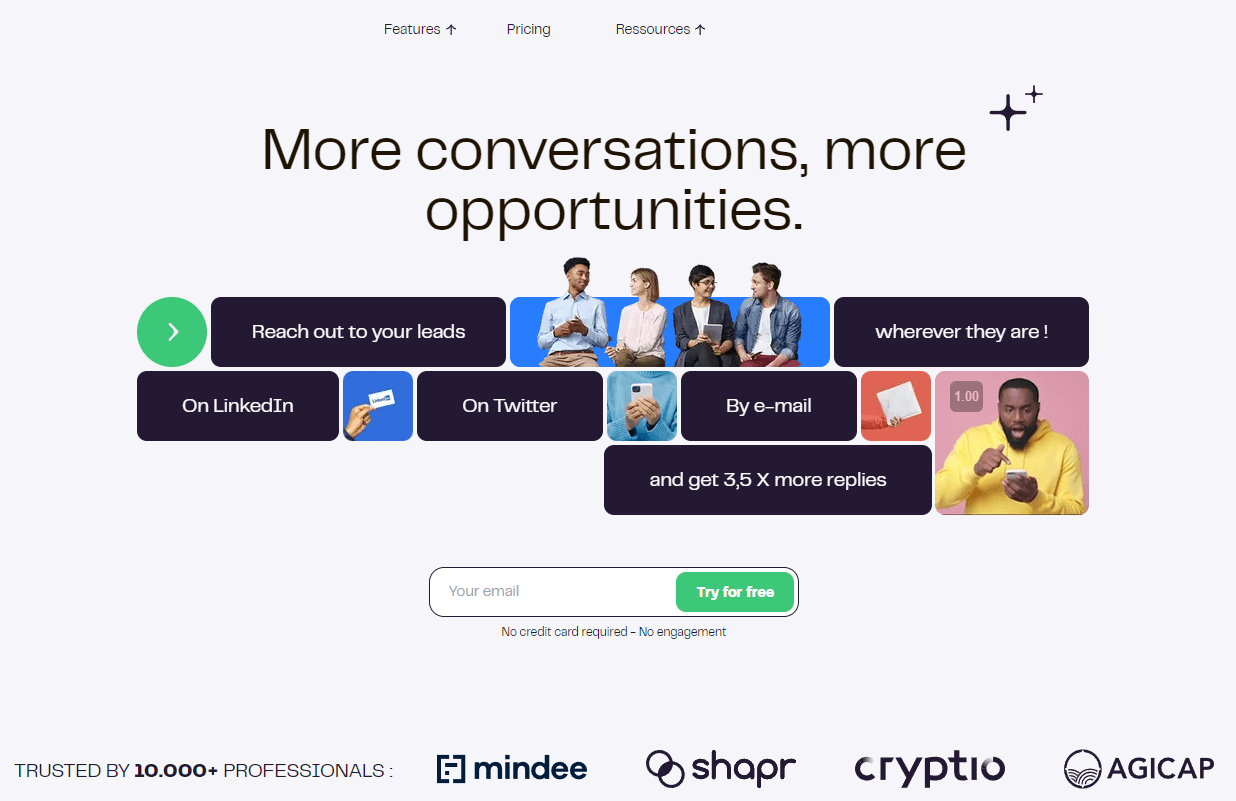
La Growth Machine is an all-in-one multichannel, cold outreach automation tool.
The outreach automation tool is a great way to introduce new touchpoints with your prospects one channel at a time.
The big benefit here is that LaGowthMachine allows you to build outreach sequences which include LinkedIn messages, cold emails, AND Twitter DMs.
So, depending on your target audience, this can be a great way to make sure you’ll get noticed.
Tool standout features
La Growth Machine offers a great way to import your contacts and engage with leads wherever they are.
Here’s how that works:
Lead enrichment – Find missing information automatically and enrich your contacts from the same platform you do outreach in.
Automated multi-channel outreach workflows – Contact leads wherever they are and automate your sales prospecting routine to save time. Channels the tool offers include (LinkedIn, email, and Twitter.
Manage leads effectively – When doing multichannel outreach at scale, centralized lead management is important. Import leads, segment audiences, avoid duplicates, and sync with your CRM to manage leads faster.
Analyse outreach performance – For each email, LinkedIn, and Twitter message sent, you can access the performance to get an overview of the bigger picture.
Integrate everywhere – Finally, you can integrate La Growth Machine with your favorite tools with no limits.
Who is the tool for
La Growth Machine is for marketers, sales teams, and other teams doing outreach at scale.
If your audience is on LinkedIn or Twitter, you can use this tool to automate your omnichannel outreach.
Though, many B2B and agency owners focus on LinkedIn instead of Twitter. So, you should double check where your audience is first.
Tool pricing
La Growth Machine scales with your needs and the main difference between the pricing plans is the features access.
Free trial – Free for 14 days with all the features available except for custom sequences.
- Basic – $53/month.
- Pro – $106/month.
- Unlimited – $160/month.
27. SocialPilot

SocialPilot is popular for scheduling social media posts, creating content, and automating workflows. It can also be used to execute a LinkedIn marketing strategy by allowing you to post simultaneously on multiple profiles or company pages.
It supports a wide range of content formats, such as images, videos, GIFs, and carousels. Your team can access this content by saving it under your own Content library and refining it, repurposing it, and prospecting.
Tool standout features
Some of SocialPilot’s features that make it a marketer’s favorite:
- Bulk Scheduling – Upload up to 500 LinkedIn posts in a click with SocialPilot’s bulk scheduling feature.
- Detailed analytics – Monitor performance metrics like post updates, followers’ growth, clicks, engagement rates, and more to get an end-to-end overview of your LinkedIn presence.
- Social Inbox – A single space to address all the user comments and mentions received on your LinkedIn company page.
- AI Assistant – SocialPilot’s AI Assistant is your go-to tool for generating hashtags and engaging content.
Who is the tool for
SocialPilot best suits:
- Marketing agencies generating MQLs
- SMBs
Tool pricing
Apart from the basic 14-day free trial, SocialPilot offers 4 pricing plans:
- Professional – $25.5/month
- Small Team – $42.5/month
- Agency – $85/month
- Agency+ – $170/month
28. LeadFuze
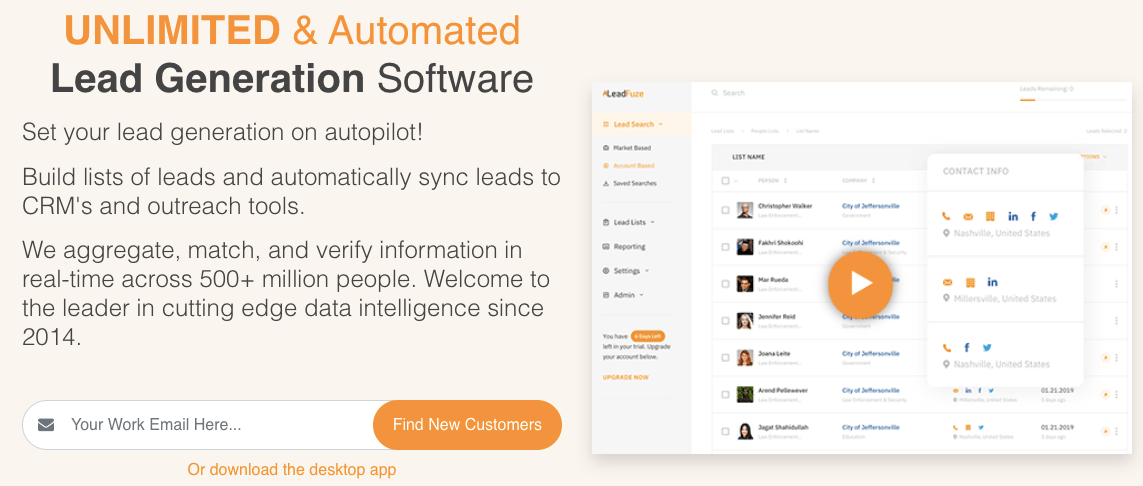
LeadFuze’s simple solutions, such as prospect list building, finding contacts, and automated emailing, make lead nurturing and prospecting easy.
LeadFuze is a lead intelligence tool that provides accurate lead data, hyper-targeted searches, and complete list building automation, saving salespeople time and effort. It can be easily integrated with internal CRMs and workflows.
Tool standout features
Top LeadFuze features worth noting:
- Data Intelligence – Offers hyper-accurate contact data by collecting and verifying details in real time across a database of millions of prospects.
- Automatic List Building – Sales teams can automate list building and sync them into their CRMs and other outreach tools for prospecting and lead nurturing.
- Passive candidate sourcing – Recruiters use LeadFuze to find personal and company emails of passive candidates so they can reach out to them on LinkedIn.
Who is the tool for
LeadFuze best suits:
- Sales and marketing team
- Recruiters
Tool pricing
Apart from a free trial, LeadFuze offers three pricing plans:
- Scaling – $147/month and up
- Unlimited – $397/month and up
- Custom – Custom pricing
29. Mailshake

Mailshake is another noteworthy and the best LinkedIn sequence tool for lead generation. Its Chrome extension lets you automate sending LinkedIn connection requests, follow-ups, and profile visits.
You can run full-fledged LinkedIn plus email campaigns and automate the outreach sequence in one go.
Tool standout features
Some of Mailshake’s best features are:
- Data Finder – You can hunt for prospect data on LinkedIn via the Chrome browser and Mailshake. For more accurate results, you can specify filters like prospect role, location, and current company.
- Social Selling – Make social selling easy and increase your average LinkedIn message reply rate by personalizing messages on auto-pilot with Mailshake’s automation features.
- Omnichannel outreach – Integrate LinkedIn messages with email campaigns for an omnichannel outreach approach. You can also automate profile views to warm up leads.
Who is the tool for
Mailshake best suits:
- Sales teams performing outreach at scale
- Brands looking to combine sales and marketing efforts
Tool pricing
Mailshake’s LinkedIn automation is part of its Sales Engagement suite:
- Sales Engagement – $85/user/month
- Email Outreach – $45/user/month (emails only)
- Starter – $25/user/month (no LinkedIn automation)
30. Octopus CRM
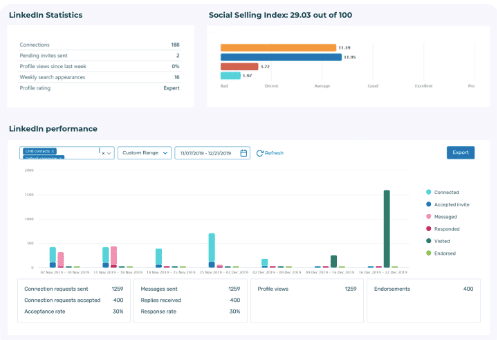
Octopus CRM is a cost-effective and all-in-one LinkedIn automation tool. It’s helpful to automate LinkedIn’s routine tasks, such as sending connection requests, visiting profiles for warm-up, messaging first-level connections, and endorsing skills.
It helps you create a complete LinkedIn marketing funnel by including several aspects, from connection requests to follow-ups.
Tool standout features
Best noteworthy Octopus CRM features for LinkedIn lead generation:
- Target audience finding – Search for your target ICP by running LinkedIn advanced filters or preparing a CSV file with LinkedIn profile URLs.
- Performance evaluation – Monitor and observe critical metrics like your SSI, number of profile views, search appearances, etc., that dictate your LinkedIn outreach.
- Email automation – Make outreach omnichannel by approaching prospects via email and ensuring you’re within LinkedIn’s safe limit.
Who is the tool for
Octopus CRM best suits:
- Sales teams and marketing professionals who are looking for some assistance in LinkedIn outreach without compromising account safety.
- Recruiters who want to reach out to potential candidates on LinkedIn.
Tool pricing
Octopus CRM has 4 pricing plans:
- Starter – $6.99/month
- Pro – $9.99/month
- Advanced – $14.99/month
- Unlimited – $24.99/month
Conclusion
And that’s a wrap!
Hope this list of some of the best LinkedIn automation tools was useful and you’re ready to start generating LinkedIn leads on autopilot.
Though, it’s important to note that, no matter which tool you choose, you should always keep LinkedIn automation best safety practices in mind.
Ideally, your tool should also be optimized for safety and growth.
And it just so happens that Expandi was made with both principles in mind.
The tool mimics human behavior so that your account isn’t suddenly blasting out 100 messages in 5 minutes (which is how many accounts often get caught), and with a dedicated IP address, your profile’s activity sessions won’t seem suspicious to LinkedIn.
Now, let’s recap some of the top questions when it comes to LinkedIn automation:
How to get more leads with Linkedin automation tools?
You can use LinkedIn automation tools like Expandi to automate your outreach and convert prospects into leads. To do that, you have to find the right audience for your niche and reach out with a personalized message.
When should I be using LinkedIn automation tools?
LinkedIn automation can save you hours of manual outreach and prospecting work. With automation, you can send the connection request and the follow-ups on autopilot while you work on your business. Done manually, you’d be writing each prospect’s first name, company name, and other information one by one for each lead.
Which is the best LinkedIn automation tool?
We may be biased, but Expandi is the best and safest LinkedIn automation tool on the market. This is because it’s cloud-based, mimics human behavior, and uses hyper-personalization when engaging with your prospects. With this in mind, LinkedIn will see your LinkedIn activity as if you’re doing all of the above manually. We’ve been using it for our own outreach campaigns too and successfully generating leads.
How can you get more leads on LinkedIn without getting banned?
LinkedIn does not like suspicious activity and spamming people. So, to get more leads without getting banned, you should: Use personalization, the right cold message templates, plan out your campaigns to make sure you’re targeting the right audience, consider using Sales Navigator for more specific leads, and finally, use the right LinkedIn automation tool so your account doesn’t get restricted.
Best LinkedIn automation tool for marketing?
Expandi was designed for marketing and growth hacking in mind. You can create marketing campaigns with follow-ups, hyper-personalize your messages, get key insights with marketing metrics, connect it with your company CRM, and more.
What are the problems that can be solved by LinkedIn automation tools?
The core problems people face with LinkedIn include: not being able to manage everything from one place, being unable to share campaign results, managing roles and permissions, and handling privacy and safety concerns. With Expandi, all these problems have a clear solution and your outreach becomes a breeze.
Is there a LinkedIn automation tool that is open-source?
Currently, no. There are no LinkedIn automation tools that are open-source. But hopefully, the above list of 10 LinkedIn automation tools was helpful for you to decide on the tool you want to use. If safety is your main concern, be sure to check out Expandi.
What are level connections on LinkedIn?
On LinkedIn, there are 3 types of connections:
1st-degree – People you’re already connected with
2nd-degree – People connected to your 1st-degree connections (mutual connections).
3rd-degree – People connected to your 2nd-degree connections (0 mutual connections).
Once you have a clear idea of who your target audience is, you can filter for the right level of connection accordingly.
Ready to start generating leads with the safest LinkedIn automation tool on the market?
Just message me on Facebook to claim your free 7-day trial.
From there, you can simply copy our top LinkedIn outreach strategies or head on over to our blog – where we cover all the latest LinkedIn growth-hacks we’ve had success with.
We also include the exact strategies we’ve used, which we break down step-by-step, and share the exact templates we used that got us more than 50 booked demos per strategy.
Recommended reading:
5 Essential Steps to Prepare Before Launching an Automated LinkedIn Outreach Campaign
Best LinkedIn Outreach Message Strategy That Gets You Light Years Ahead of Your Competition
LinkedIn Personalization Growth Hack Beyond First Name and Last Name For 2024
You’ve made it all the way down here, take the final step
